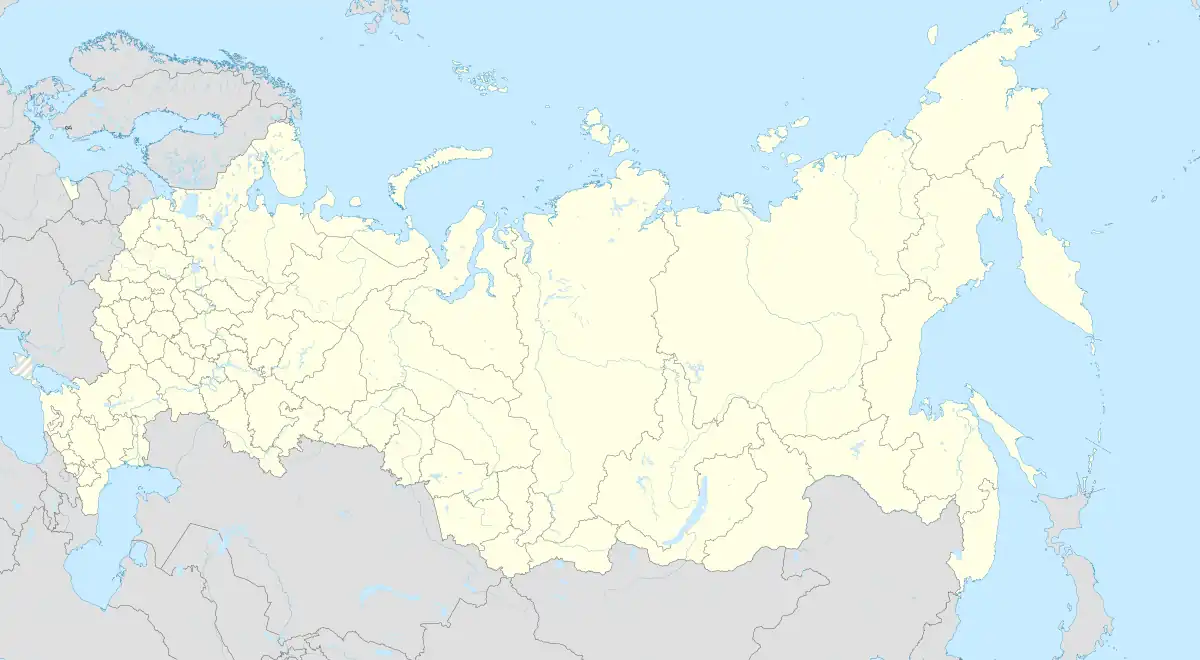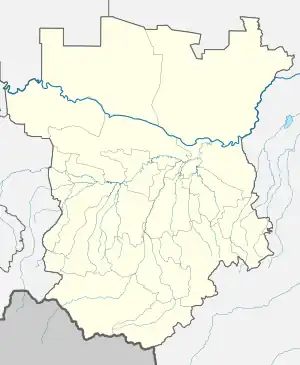Bamut
Bamut[lower-alpha 1] is a non-residential rural locality (a selo) in Sernovodsky District of the Republic of Chechnya, Russia.
Bamut
Бамут | |
|---|---|
| Other transcription(s) | |
| • Chechen | Буммат |
Location of Bamut | |
 Bamut Location of Bamut  Bamut Bamut (Chechnya) | |
| Coordinates: 43°09′48″N 45°12′03″E | |
| Country | Russia |
| Federal subject | Chechnya |
| Elevation | 350 m (1,150 ft) |
| Population | |
| • Total | 6,025 |
| • Estimate (2021)[2] | 5,838 |
| • Subordinated to | Sernovodsky District |
| Time zone | UTC+3 (MSK |
| Postal code(s)[4] | 366610 |
| OKTMO ID | 96631409101 |
Administrative and municipal status
Municipally, Bamut is incorporated as Bamutskoye rural settlement. It is the administrative center of the municipality and is the only settlement included in it.[6]
Geography
_to_8_Sep_2019.png.webp)
_after_8_Sep_2019.png.webp)
Bamut is located on both banks of the Fortanga River. It is located 8 kilometres (5 mi) west of the town of Achkhoy-Martan and 50 kilometres (31 mi) west of the city of Grozny.
The nearest settlements to Bamut are Katyr-Yurt in the east, Shalazhi, Stary Achkhoy and Yandi in the south-east, Arshty in the south-west, Nesterovskaya in the north-west, and Assinovskaya and Novy Sharoy in the north.[7]
History

The first map which mentions the village of Bamut, dates back to 1847.[8] The village does not appear on earlier maps.[9]
In 1859, caucasologist and military-historian Adolf Berge in his principal work Chechnya and Chechens mentioned Bamut among the Galashian villages.[10]
From 1922 to 1934, Bamut was a part of the Ingush Autonomous Oblast.
On May 26 1926, 50 Cossacks of the Assinovskaya stanitsa who went to mow grass near the Ingush village of Bamut, were surrounded by up to 100 Ingush people with a demand to follow them. Some of the Cossacks fled, and the remaining 11 were captured and taken away by the Ingush to the village Bamut, where they were accused of mowing grass on lands belonging to the Ingush.[11]
In 1944, after the genocide and deportation of the Chechen and Ingush people and the Chechen-Ingush ASSR was abolished, the village of Bamut was renamed to Bukovka, and settled by people from the neighboring republic of Dagestan.[12] From 1944 to 1957, it was a part of the Vedensky District of the Dagestan ASSR.
In 1958, after the Vaynakh people returned and the Chechen-Ingush ASSR was restored, the village regained its old Chechen name, Bummat.[13]
During the First Chechen War, the infamous Battle of Bamut occurred in the village.
At the start of the Second Chechen War, in the fall of 1999, the territory of Bamut was completely closed to civilians. The settlement was only unblocked again in April 2002.[14]
In the fall of 2014, by decree of the leadership of the Chechen Republic, a large-scale restoration of the village, which was completely destroyed, was launched. The opening of the revived village of Bamut took place on 3 December 2014.[15][16]
On 8 September 2019, a referendum was held in Bamut on the transfer of the settlement to the Chechen section of Sunzhensky District. According to the official results, 1,565 people (73.61% of residents of Bamut) took part in the referendum, in which 84.98% of people voted in favor of the transfer, and 14.82% of people voted against it.[17]
Population
Population of Bamut was majority Ingush in 1926.[18]
According to the results of the 2010 Census, the majority of residents of Bamut (6,013 or 99.80%) were ethnic Chechens, with 12 people (0.20%) coming from other ethnic backgrounds.
According to the 2002 Census, 5,137 people (2,465 men and 2,672 women) lived in Bamut.
Notes
References
- Russian Federal State Statistics Service (2011). Всероссийская перепись населения 2010 года. Том 1 [2010 All-Russian Population Census, vol. 1]. Всероссийская перепись населения 2010 года [2010 All-Russia Population Census] (in Russian). Federal State Statistics Service.
- "Таблица 5. Численность населения России, федеральных округов, субъектов Российской Федерации, городских округов, муниципальных районов, муниципальных округов, городских и сельских поселений, городских населенных пунктов, сельских населенных пунктов с населением 3000 человек и более". Всероссийской переписи населения 2020 года
- "Об исчислении времени". Официальный интернет-портал правовой информации (in Russian). 3 June 2011. Retrieved 19 January 2019.
- Почта России. Информационно-вычислительный центр ОАСУ РПО. (Russian Post). Поиск объектов почтовой связи (Postal Objects Search) (in Russian)
- "Ярташ". "Даймохк" газет (in Russian).
- "Сельское поселение Бамутское (Чеченская Республика)". www.bankgorodov.com.
- "Карта Чеченской республики подробная с районами, селами и городами. Схема и спутник онлайн". 1maps.ru.
- Карта Кавказского края 1847 г. // РГВИА. Ф. 386. Оп. 1. Д. 297. Л. 14.
- Дзурдзуки (2019-08-17). "Историческая справка о сельском поселении Бамут" [Historical information about the rural settlement of Bamut]. www.durdzuki.com (in Russian).
- Берже 1859, p. 117.
- "Обзор политического состояния СССР за июнь. 31 июля 1926 г. // ЦА ФСБ РФ. Ф.2. Оп.4. Д.439. Л.151-183. Заверенная копия.". «Совершенно секретно»: Лубянка — Сталину о положении в стране (1922-1934 гг.): Сб. док. в 10 т. Т.4 в 2 ч. 1926 г. Ч.1 (in Russian). Москва. 2001.
{{cite book}}: CS1 maint: location missing publisher (link) - "Потери вооруженных сил России и СССР в вооруженных конфликтах на Северном Кавказе (1920–2000 годы)". www.demoscope.ru.
- "О восстановлении Чечено-Ингушской АССР и упразднении Грозненской области". lawru.info (in Russian). Archived from the original on 2019-08-06. Retrieved 2019-09-21.
- Узел, Кавказский. "Первые жители вернулись в Бамут". Кавказский Узел.
- Узел, Кавказский. "В Чечне завершено восстановление села Бамут". Кавказский Узел.
- "Восстановление села Бамут в Чечне завершено". ИА Чеченинфо (in Russian).
- "Подведены предварительные итоги единого дня голосования 8 сентября 2019 года в Чеченской Республике". www.chechen.izbirkom.ru.
- Северо-Кавказское кравое статистическое управление (1929). Поселенные итоги переписи 1926 года по Северо-Кавказскому краю [Settled results of the 1926 census in the North Caucasus region] (in Russian). Ростов-на-Дону: Отдел переписи. p. 405.
- Kashnitsky, Ilya (11 April 2017). "Municipality level Russian Census data 2002 and 2010". doi:10.17605/OSF.IO/CSKMU.
{{cite journal}}: Cite journal requires|journal=(help) - "ВПН-2010". www.gks.ru.
Bibliography
- Берже, А. П. (1859). Чечня и чеченцы [Chechnya and Chechens] (in Russian). Тифлис: Типография Главного Управления Наместника Кавказского. pp. 1–141.
- Берже, А. П. (1991) [1859]. Куприянова, Е. А. (ed.). Чечня и чеченцы [Chechnya and Chechens] (in Russian). Грозный [Тифлис]: Книга [Тип. гл. упр. Наместника Кавк.] pp. 1–107.
- Ужахов, М. Г. (1927). Ингушско-русский словарик [Ingush-Russian dictionary] (in Ingush and Russian). Владикавказ: Крайнациздат. pp. 1–185.
- Барахоева, Н. М.; Кодзоев, Н. Д.; Хайров, Б. А. (2016). Ингушско-русский словарь терминов [Ingush-Russian dictionary of terms] (in Ingush and Russian) (2 ed.). Нальчик: ООО «Тетраграф». pp. 1–288.
- Кодзоев, Н. Д. (2021). Хайрова, Р. Р. (ed.). Русско-ингушский словарь [Russian-Ingush dictionary] (in Ingush and Russian). Ростов-на-Дону. pp. 1–656. ISBN 978-5-906785-55-8.
{{cite book}}: CS1 maint: location missing publisher (link) - Общенациональная Комиссия по рассмотрению вопросов, связанных с определением территории и границ Ингушетии (2021). Всемирный конгресс ингушского народа (ed.). Доклад о границах и территории Ингушетии (общие положения) [Report on the borders and territory of Ingushetia (general provisions)] (archival documents, maps, illustrations) (in Russian). Назрань. pp. 1–175.
{{cite book}}: CS1 maint: location missing publisher (link) - Мальсагов, З. К. (1963). Оздоева, Ф. (ed.). Грамматика ингушского языка [Grammar of the Ingush language] (in Ingush and Russian). Vol. 5 (2nd ed.). Грозный: Чечено-Ингушское Книжное Издательство. pp. 1–164.
- Оздоев, И. А. (1980). Оздоева, Ф. Г.; Куркиев, А. С. (eds.). Русско-ингушский словарь: 40 000 слов [Russian-Ingush dictionary: 40,000 words] (in Ingush and Russian). Москва: Русский язык. pp. 1–832.